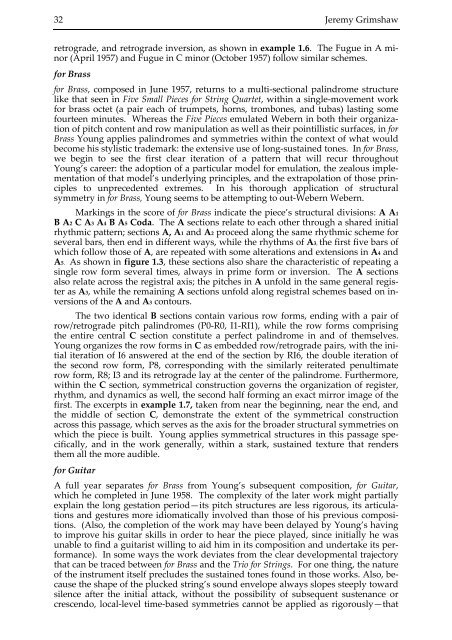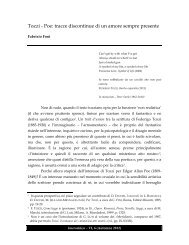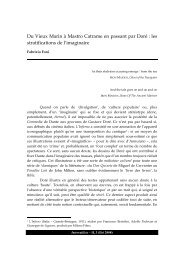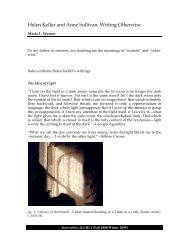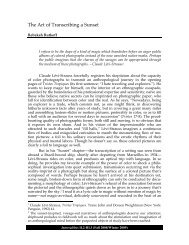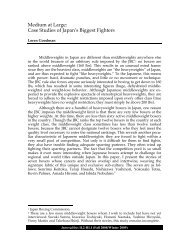The Tabula (not so) Rasa: La Monte Young's Serial Works ... - Cipa
The Tabula (not so) Rasa: La Monte Young's Serial Works ... - Cipa
The Tabula (not so) Rasa: La Monte Young's Serial Works ... - Cipa
You also want an ePaper? Increase the reach of your titles
YUMPU automatically turns print PDFs into web optimized ePapers that Google loves.
32 Jeremy Grimshaw<br />
retrograde, and retrograde inversion, as shown in example 1.6. <strong>The</strong> Fugue in A minor<br />
(April 1957) and Fugue in C minor (October 1957) follow similar schemes.<br />
for Brass<br />
for Brass, composed in June 1957, returns to a multi-sectional palindrome structure<br />
like that seen in Five Small Pieces for String Quartet, within a single-movement work<br />
for brass octet (a pair each of trumpets, horns, trombones, and tubas) lasting <strong>so</strong>me<br />
fourteen minutes. Whereas the Five Pieces emulated Webern in both their organization<br />
of pitch content and row manipulation as well as their pointillistic surfaces, in for<br />
Brass Young applies palindromes and symmetries within the context of what would<br />
become his stylistic trademark: the extensive use of long-sustained tones. In for Brass,<br />
we begin to see the first clear iteration of a pattern that will recur throughout<br />
Young’s career: the adoption of a particular model for emulation, the zealous implementation<br />
of that model’s underlying principles, and the extrapolation of those principles<br />
to unprecedented extremes. In his thorough application of structural<br />
symmetry in for Brass, Young seems to be attempting to out-Webern Webern.<br />
Markings in the score of for Brass indicate the piece’s structural divisions: A A1<br />
B A2 C A3 A4 B A5 Coda. <strong>The</strong> A sections relate to each other through a shared initial<br />
rhythmic pattern; sections A, A1 and A2 proceed along the same rhythmic scheme for<br />
several bars, then end in different ways, while the rhythms of A3, the first five bars of<br />
which follow those of A, are repeated with <strong>so</strong>me alterations and extensions in A4 and<br />
A5. As shown in figure 1.3, these sections al<strong>so</strong> share the characteristic of repeating a<br />
single row form several times, always in prime form or inversion. <strong>The</strong> A sections<br />
al<strong>so</strong> relate across the registral axis; the pitches in A unfold in the same general register<br />
as A3, while the remaining A sections unfold along registral schemes based on inversions<br />
of the A and A3 contours.<br />
<strong>The</strong> two identical B sections contain various row forms, ending with a pair of<br />
row/retrograde pitch palindromes (P0-R0, I1-RI1), while the row forms comprising<br />
the entire central C section constitute a perfect palindrome in and of themselves.<br />
Young organizes the row forms in C as embedded row/retrograde pairs, with the initial<br />
iteration of I6 answered at the end of the section by RI6, the double iteration of<br />
the second row form, P8, corresponding with the similarly reiterated penultimate<br />
row form, R8; I3 and its retrograde lay at the center of the palindrome. Furthermore,<br />
within the C section, symmetrical construction governs the organization of register,<br />
rhythm, and dynamics as well, the second half forming an exact mirror image of the<br />
first. <strong>The</strong> excerpts in example 1.7, taken from near the beginning, near the end, and<br />
the middle of section C, demonstrate the extent of the symmetrical construction<br />
across this passage, which serves as the axis for the broader structural symmetries on<br />
which the piece is built. Young applies symmetrical structures in this passage specifically,<br />
and in the work generally, within a stark, sustained texture that renders<br />
them all the more audible.<br />
for Guitar<br />
A full year separates for Brass from Young’s subsequent composition, for Guitar,<br />
which he completed in June 1958. <strong>The</strong> complexity of the later work might partially<br />
explain the long gestation period—its pitch structures are less rigorous, its articulations<br />
and gestures more idiomatically involved than those of his previous compositions.<br />
(Al<strong>so</strong>, the completion of the work may have been delayed by Young’s having<br />
to improve his guitar skills in order to hear the piece played, since initially he was<br />
unable to find a guitarist willing to aid him in its composition and undertake its performance).<br />
In <strong>so</strong>me ways the work deviates from the clear developmental trajectory<br />
that can be traced between for Brass and the Trio for Strings. For one thing, the nature<br />
of the instrument itself precludes the sustained tones found in those works. Al<strong>so</strong>, because<br />
the shape of the plucked string’s <strong>so</strong>und envelope always slopes steeply toward<br />
silence after the initial attack, without the possibility of subsequent sustenance or<br />
crescendo, local-level time-based symmetries can<strong>not</strong> be applied as rigorously—that


